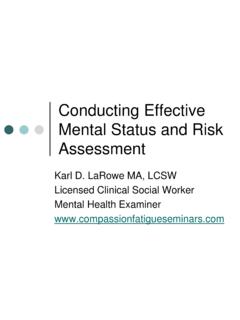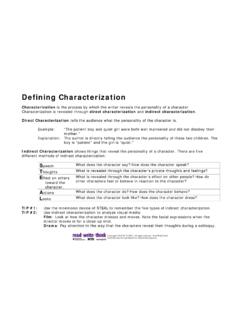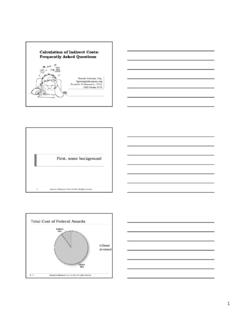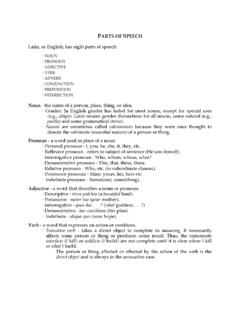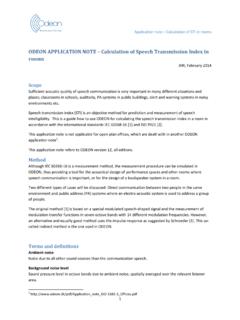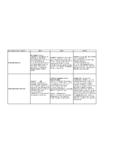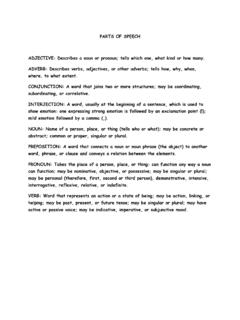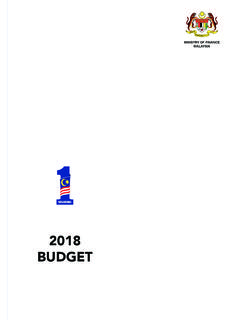Transcription of Effective and Efficient Speech Language Pathology Services
1 Effective and Efficient Speech Language Pathology Services : What Directors Need to Know Kathy Clapsaddle, , CCC-SLP Special Education Coordinator Region XIII Education Service Center Something to Talk About: SLP Services in the Schools: How do we know .. Functional Outcomes An accounting of the cost, time and resulting restoration (or newly acquired performance) of the [student] (Moore, and Montgomery, 2008). This may include progress in the TEKS or in life-skills instruction, friendship development, and age-appropriate independence. Questions to consider (Moore and Montgomery, 2008, p. 189): 1. Can Speech - Language pathologists rely on standardized test scores to capture the improvement? 2. Is it more authentic if persons other than Speech - Language pathologists report the changes they observe?
2 3. Do others besides the student know if the intervention was helpful? 4. Do Speech - Language pathologists know if most students with similar diagnoses make similar improvements? How can this be found out? If students do not, why not? 5. Does the student s rate of improvement change with different Speech - Language pathologists? 6. Does one service provider see results more quickly or more slowly than another? How can Speech - Language pathologists alter that rate? DO SLP Services MAKE A DIFFERENCE? Research says YES! How do we know it? When you provide Services for a student with a COMMUNICATION DISORDER, how do you determine that the intervention has made a meaningful difference in that student s life? Page 1 of 19 Four Essential Questions for Functional Outcomes What data do we need to answer this question?
3 Do we have the data? 1. How many sessions does it take to show meaningful change? 2. How will each assessment streamline the costs of serving this student? 3. Is this the most cost- Effective way to provide this service? 4. Can you prove that the Services you provide make a difference for the student? (Moore & Montgomery, 2008) Program Intensity and Service Delivery in the Schools: (Brandel and Loeb, 2011) Surveyed over 1800 school SLPs Researchers found, little variability across disabilities and severity level with respect to program intensity and service delivery model (p. 471). Program intensity of 1 or 2 times per week for 20-30 minute sessions was most frequently recommended Caseload size influenced program intensity There are no efficacy studies that have evaluated the claim that 2 3 times a week for 20 30 min in group settings outside of the classroom is an Effective service delivery model (p.)
4 475) . Intensive Service Delivery (Gillam and Frome-Loeb, 2010): Students: 216 school age students in Texas and Kansas Four Common Characteristics of Treatment Four treatment conditions How Many Sessions? Page 2 of 19 Pre and Post-test: Administered battery of tests, including Comprehensive Assessment of Spoken Language (CASL) Compared to: pre and post-test standard scores on the Test of Language Development Primary (3rd edition) from a large group (n=156) of same-age children who had participated in a longitudinal epidemiological study in Iowa (Tomblin et al., 1997; Tomblin et al., 2003). Children in the Iowa study received intervention in public school settings twice each week for 20-minute sessions for two years (an approximate total of 48 hours). Results: Improved significantly in Continued to improve for 6 months.
5 Improvement was FIVE times greater than the improvement seen in Iowa Study after 2 years. Provided Intensive SLP Services Trial in 3 ESC Region XIII districts Summer 2011. Quantitative Data: n = 15 Pre-post effect change on Story Retelling = Pre-post effect change on Vocabulary = What was most beneficial to your students 100% Narrative Intervention , 75% Daily Contact with Therapist 100% of clinicians rated progress by students as Good 100% of clinicians integrated therapy strategies into intervention 100% of clinicians would be interested in participating again this summer 100% of clinicians rated their administrator s response as liked a lot Qualitative data: The parents commented that they had noticed an increase in expressive Language at home during the summer pilot period of 4 weeks.
6 Students with the weakest Language skills made the greatest progress. The program gave me a framework for introducing and then continuing on with a higher level of narrative. Some students were able to tell me how they used the structure when writing for their STARR practice writing test. Similar results as Barratt et al. (1992) study with preschool children: Students with intensive intervention programs showed greater improvement in Language expression than students in once-weekly Services Page 3 of 19 In a 40-student caseload, 10 students would be served daily for 9 weeks. Between direct service periods, SLPs provided progress monitoring and met with teachers - Nicole Power and Kim Kysar, Bethany and Yukon Public Schools What makes ANY Intervention More Intensive (Montgomery, 2006): Many repetitions to trigger retention Conducted over short periods of time High level of engagement Provide homework Self-regulation Provide collaborative instruction with teacher Need consistent eligibility processes to assure.
7 No more testing is done than is necessary Accurate information is gathered through assessments Assessment data supports the development IEP that removes barrier to access of the curriculum Only students with disabilities are found eligible for Services Texas Speech Language Hearing Association Eligibility Guidelines Purpose: to provide structure within which the multidisciplinary team and the Speech - Language pathologist in particular can complete a comprehensive evaluation of a student s communication skills and make recommendations to the ARD Committee regarding eligibility using evidence-based methodology and tools. Follows a 3- Stage Process for Determining Eligibility: Stage 1: Is there a disability condition ( , a communication disorder)? Stage 2: Is there an adverse effect on educational performance (academic achievement and functional performance) resulting from the communication disorder?
8 Stage 3: If so, are specially designed instruction and/or related Services and supports needed from the SLP to help the student make progress in the general education curriculum? Guidelines available in the following areas: Generic Eligibility Principles Articulation & Articulation for Students who are Culturally and Linguistically Diverse Language & Language and Learning Disabilities Voice Fluency (Stuttering) Language and Intellectual Disabilities and/or Autism (webcasts forthcoming spring 2012) Language for Students who are Culturally and Linguistically Diverse (TBA) All Guideline Trainings available on the Web: How will Each Assessment Streamline Costs? Page 4 of 19 It is no longer appropriate for Speech - Language pathologists to provide their Services independently.
9 The classroom teacher is the expert on curriculum. The Speech - Language pathologist is the expert on Language acquisition. Putting those two together will facilitate the most efficacious treatment for the student - Campbell, 1999, p. 7. How are we currently providing Services ? Office of Special Education Programs Visit to Texas 2002 Reported Patterns of Service Delivery for Related Services and SLP Services ASHA Schools Survey 2010 (over 2800 SLPs nationally) 71% of service delivery reported to be pull out Services 21% of service delivery reported to be classroom or curriculum based Type of Service What does this look like? Indirect Services Providing interventions/ strategies to teacher to implement Training teachers/ paraprofessionals to provide interventions Monitoring generalization of skills (7% in elementary settings) Collaborative/ Classroom-Based Services delivered in the classroom in a co-teaching arrangement Meeting with teacher to determine student s instructional barriers Whole-class instruction or small group within a classroom ( , center, literacy workstation) (17% in elementary settings) Pull-Out Settings outside the regular or special education classroom Individualized or small group The Speech Room Most frequently used service delivery model (75% in elementary settings)
10 Self-Contained Speech Class for students whose primary handicapping condition is communication Seen frequently in preschool settings Intensive, daily intervention I see twice-a-week-for-30-minutes pullout therapy models as very expensive. We have not shown efficacy or efficiency in moving students through their course of treatment using the traditional pullout model (Moore, 2010) Classroom-Based/Collaborative Service Model: Can include: Team teaching with classroom teacher Working with small groups (centers, stations) in the classroom Leading instruction with teacher assisting in data collection Using classroom materials to prime students prior to classroom instruction Is This the Most Cost- Effective Way? Page 5 of 19 In the past, we never had time to meet with teachers, know what s coming up in a curriculum, or be able to consult with teachers about students needs in the classroom.

